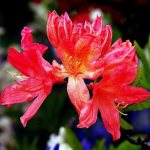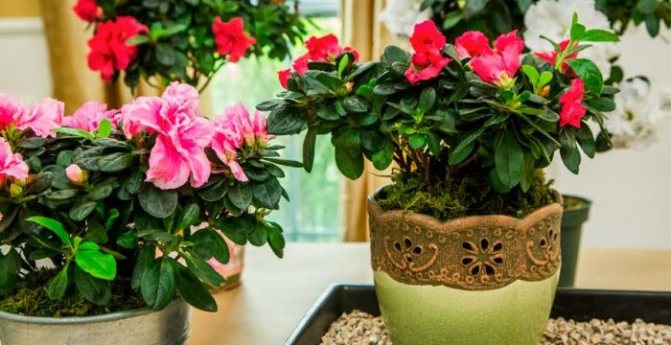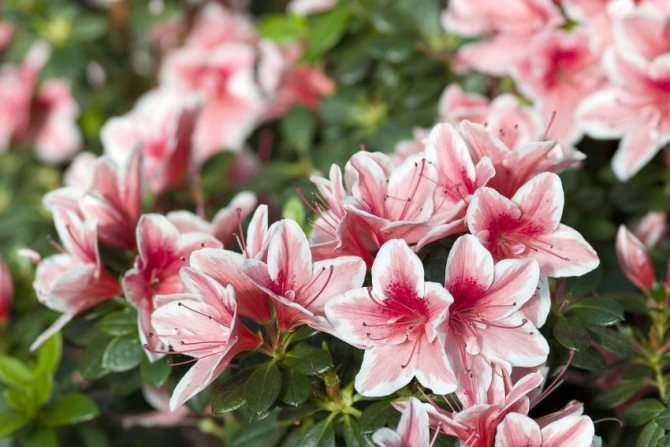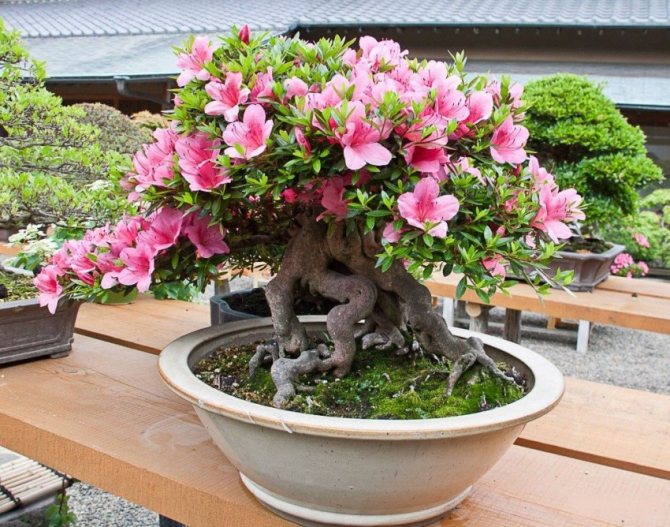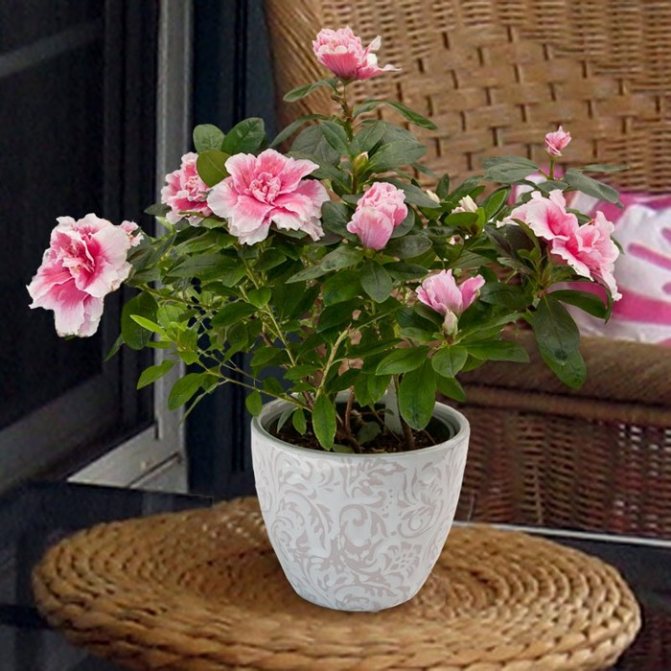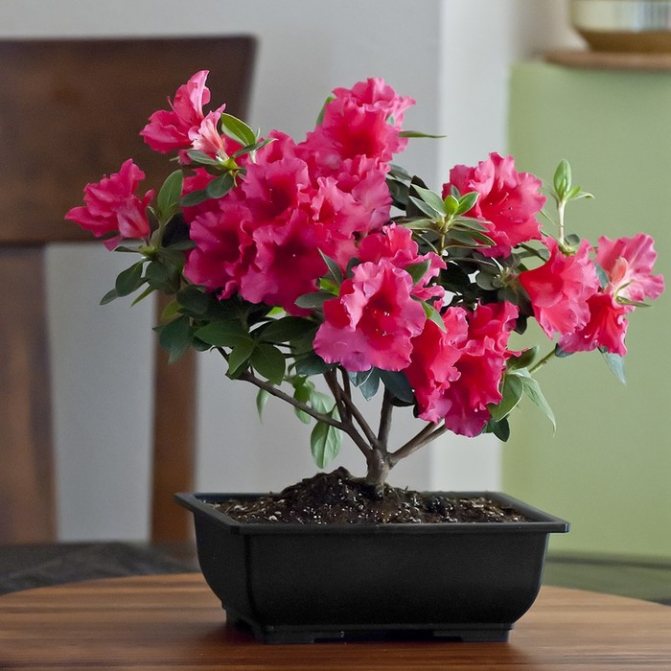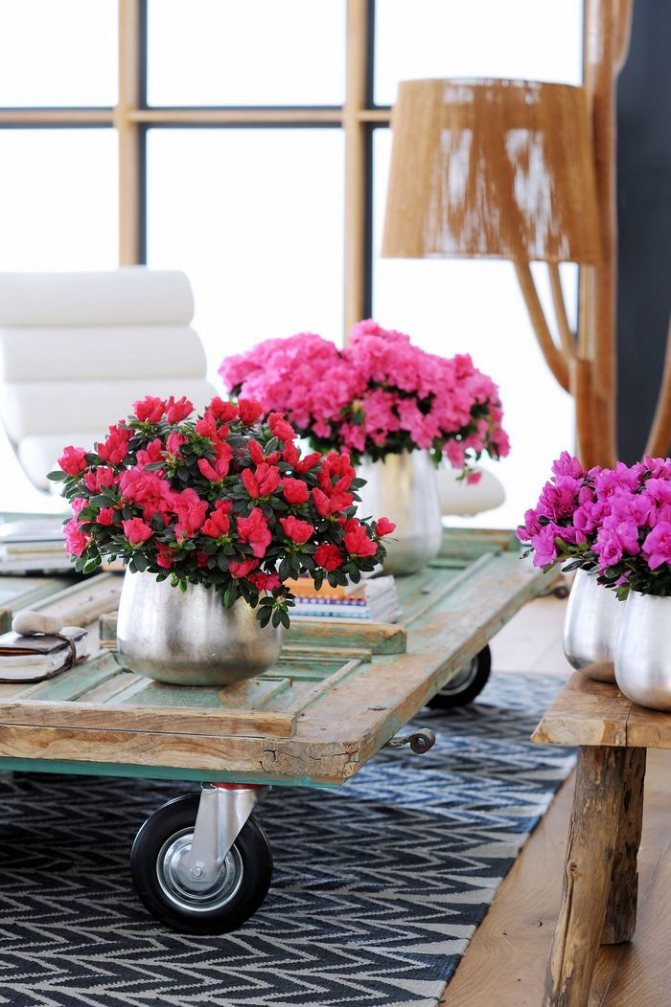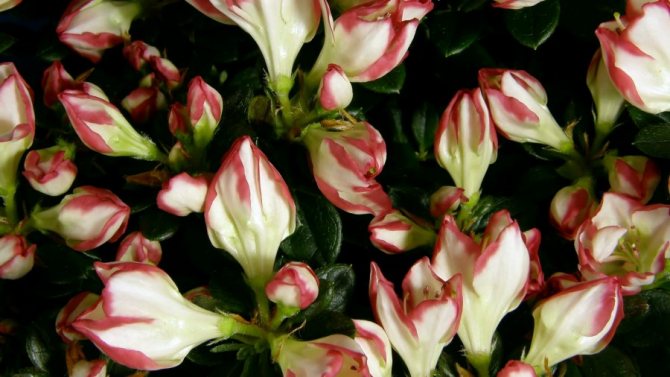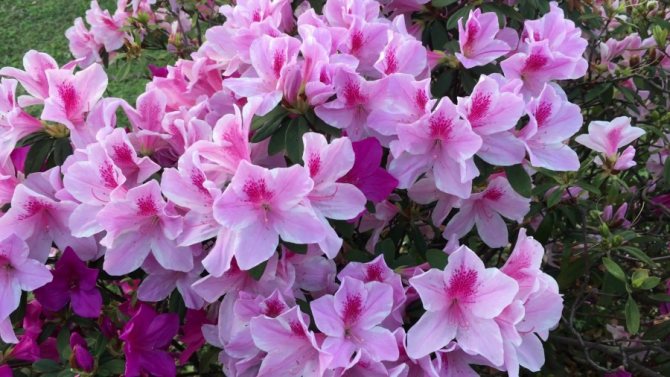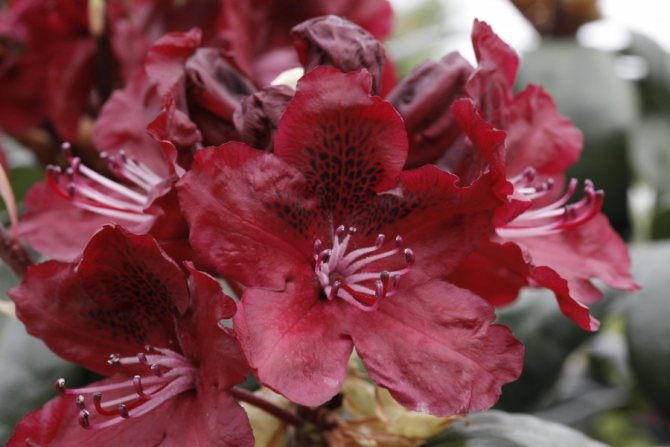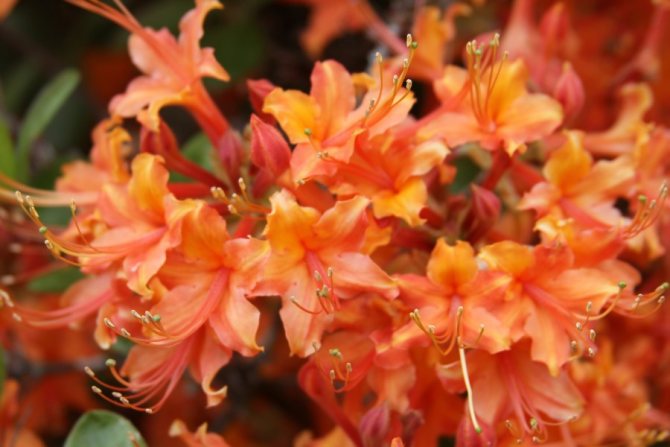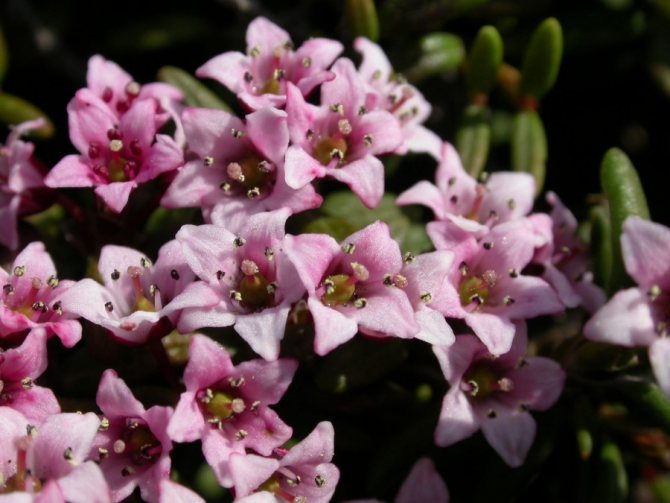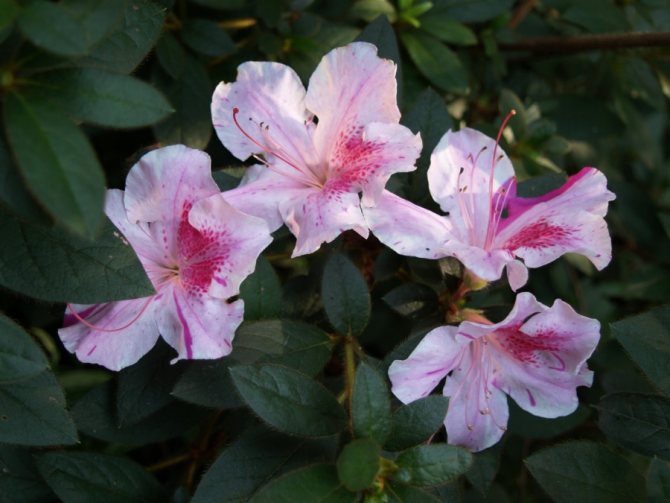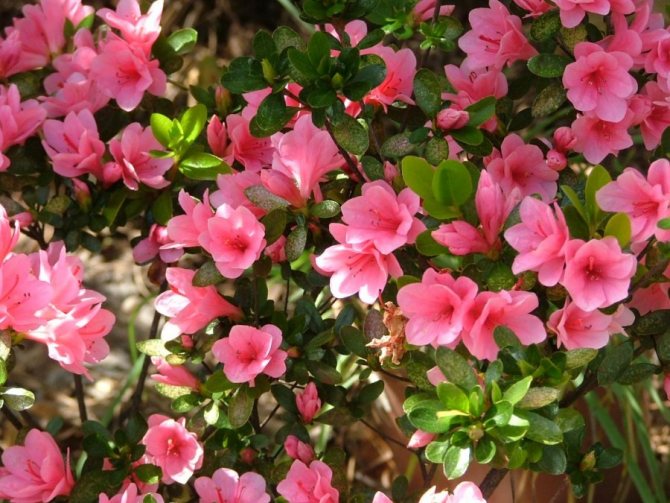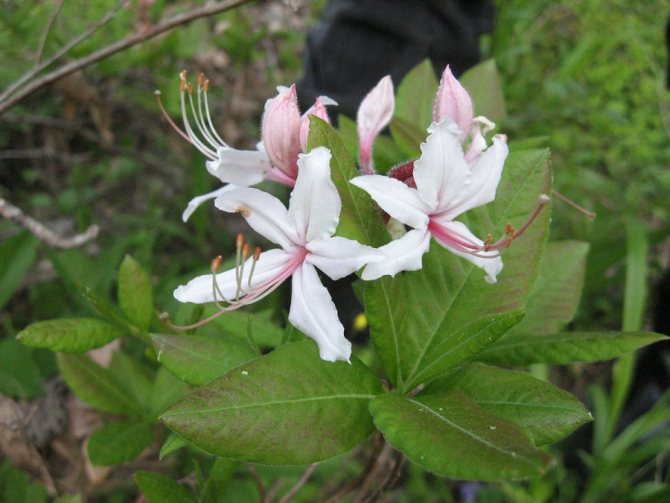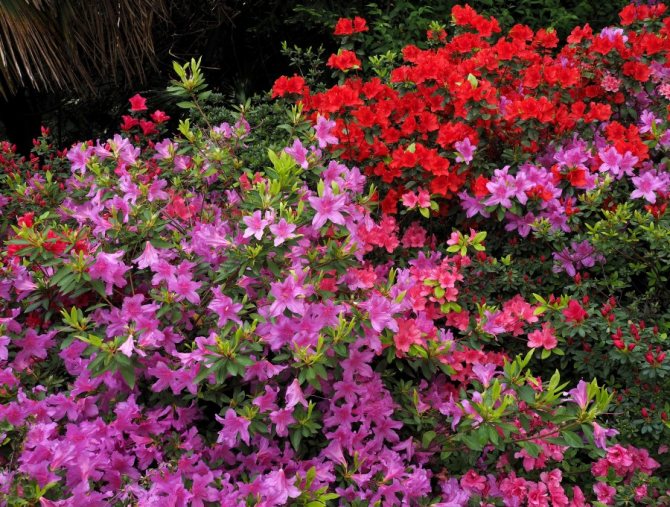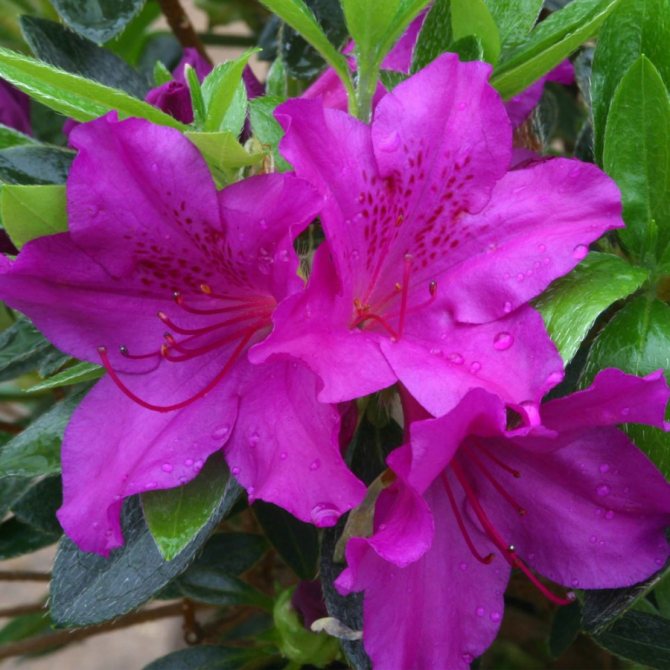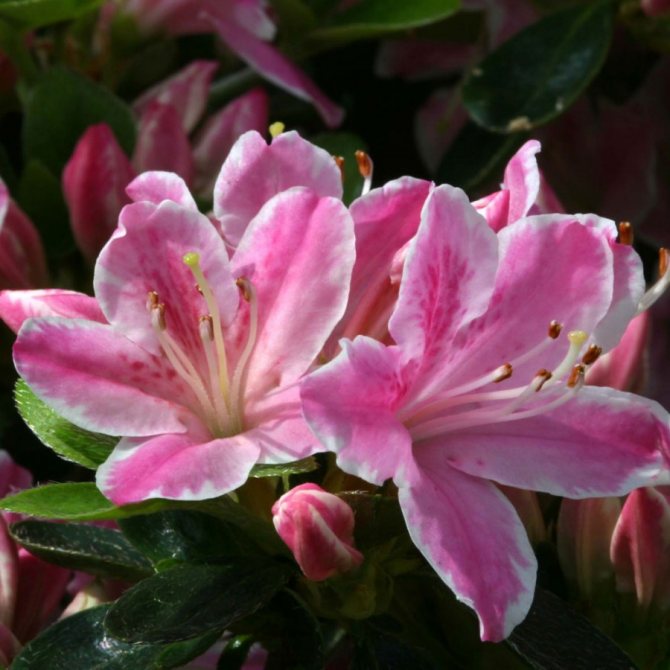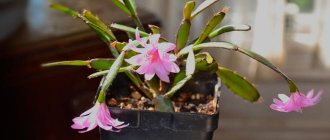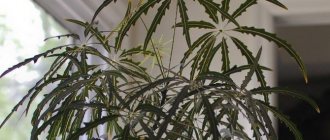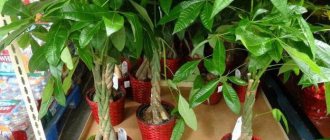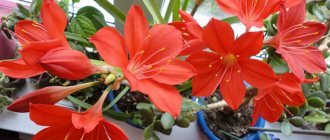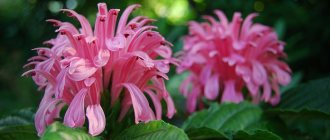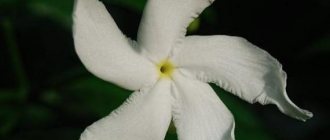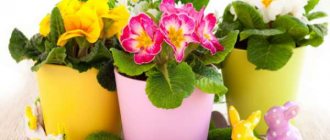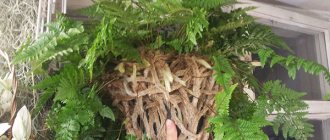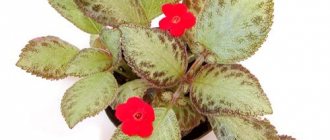Photo of indoor rhododendron Azalea (Azalea) or indoor rhododendron is a perennial flowering plant representing the Heather family... In translation, the name means "rosewood". The homeland of the flower is Japan, China, India.
At home, an azalea is a small, strongly branching bush, 12-50 cm high. When forming a standard tree, the height may be greater.
The flower grows very slowly: in a year it adds only a few centimeters. Dark green leaves, up to 3.5 cm long, have an elliptical shape and a glossy surface.
Flowering occurs in the autumn-winter period. Funnel-shaped flowers can be simple or double, 3-7 cm in diameter. Their color is usually bright one-color: red, white, pink, purple. Bred varieties with bicolor and variegated petals.
Be sure to see beautiful flowers such as hydrangea and oleander.
| The flower grows very slowly: in a year it adds only a few centimeters. |
| Flowering occurs in the autumn-winter period. |
| The plant requires special care. |
| Perennial |
2. Planting and care in the open field
The main challenge when growing outdoors is maintaining proper acidic pH soil and good preparation for wintering.
Landing in open ground is carried out in the warm season - from spring to mid-autumn, when there are no prolonged frosts.
For azaleas, a location is prepared that will be closed from too hot rays of the sun at noon, you can plant a flower under the canopy of trees. Also, such a place should be protected from strong gusts of wind.
↑ Up,
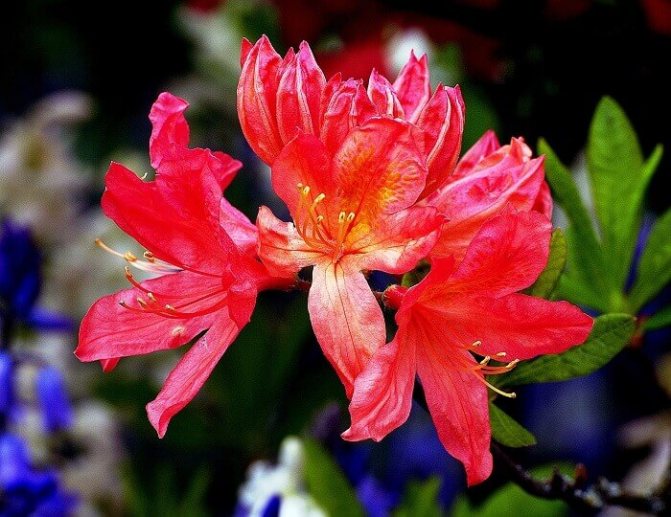
You may also be interested in:
- Gloxinia - flower photo, home care, description of varieties, growing from seeds, flowering time of indoor plants, diseases and pests, leaf propagation, watering, why spots appear on the leaves
- Astilba - photo, planting and care in the open field, description of the flower, varieties and types of plants, use in landscape design, growing at home, flowering time, height, soil selection
- Eustoma - photo of color, growing from seeds, planting and care in the open field and at home, in a pot, what does indoor lisianthus look like, soil, varieties, flowering
- Ranunculus - a photo of a flower, planting and care in the open field, growing at home from seeds, keeping in a pot, description, flowering time in a flower bed and at home, description of plant varieties
- Physalis - photo, growing and care in open ground, planting at home, useful properties of berries, what it looks like - description of varieties, growing from seeds, flowering time, fruiting, diseases and pests
↑ Up,
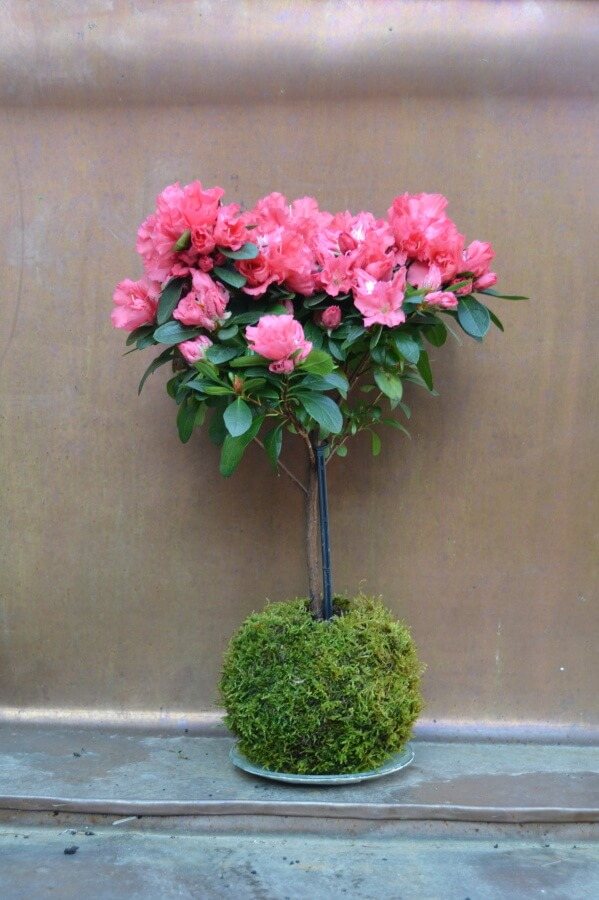

Prepare for planting holes with a depth of 40 to 50 cm, a good layer of drainage is placed on the bottom in the form of broken clay pots, expanded clay and coarse river sand.
For filling holes make up the soil with a sufficient amount of sour peat, fallen needles and tree bark.
The flower is taken out of the transport container and transferred into the hole, if possible, preserving an earthen lump. Since the azalea grows in symbiosis with special fungi - mycorrhiza, the presence of old soil is necessary.
Around the perimeter, the bushes are sprinkled with a fresh, peat-based mixture and the substrate is tamped around the foot of the plant to remove air pockets.
↑ Up,
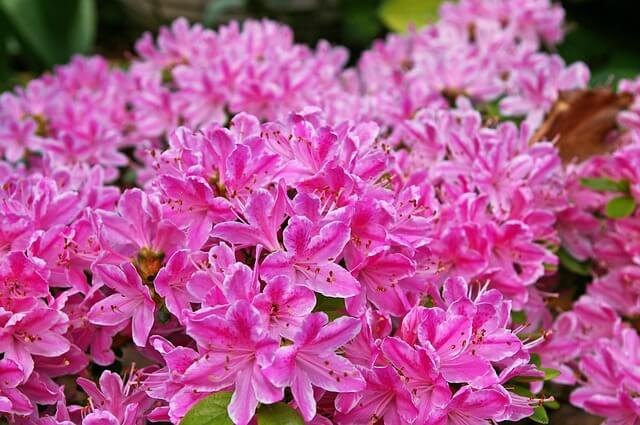

Landing scheme will depend on the final size of the plants - a distance of about 1 - 1.5 m.while smaller varieties can be planted at a distance 50 - 70 cm.
Flower bases are desirable cover with mulch based on pine bark - it will prevent the appearance of weeds and prevent the rapid evaporation of moisture from the soil surface.
After planting bushes watered abundantlyby adding dry mycorrhiza powder, which can be purchased at a flower shop, to the water for irrigation. Only planted plants will need regular and abundant watering.
↑ Up,
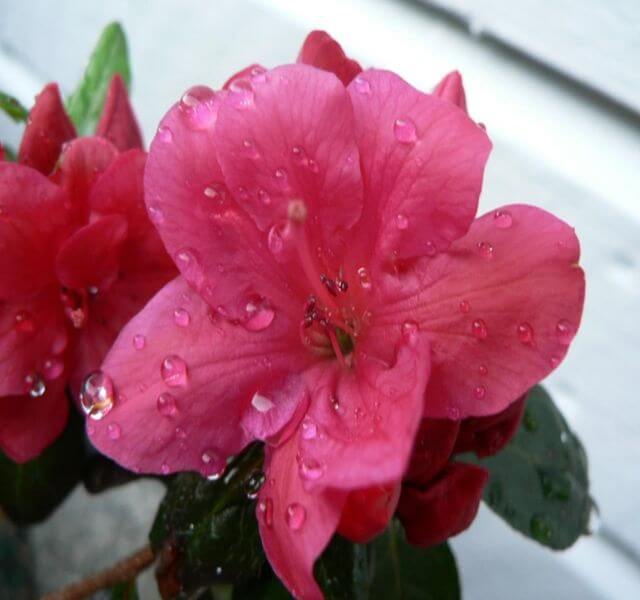

Further care for the planted plants will consist in timely watering and feeding, as well as loosening the soil.
Since the root system of rhododendron is located superficially, then loosening should be done with caution, and also to prevent overdrying of the soil.
For feeding use only fertilizers specially designed for azaleas and rhododendrons - they will help to maintain the required low pH level of the soil. From time to time, you can use foliar dressing with iron chelate, applying it to the leaf blades with a spray bottle.
↑ Up,
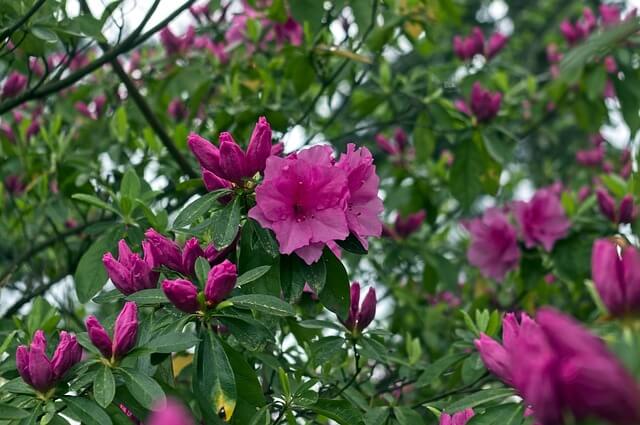

2.1 Preparation for wintering
Before the onset of frost, around the middle of autumn, the bushes are very spilled abundantly with water and spread at their foot thick layer of mulch.
In the middle lane for growing outdoors, it is worth using only deciduous plants that tolerate frost better.
For insulation Plants use spruce branches, fallen leaves or non-woven material, on top of such shelters are sprinkled with snow.
So that the flower does not fall out, a small slate shelter is also erected above it.
As soon as the snow melts in this area, the shelter is immediately removed.
↑ Up,
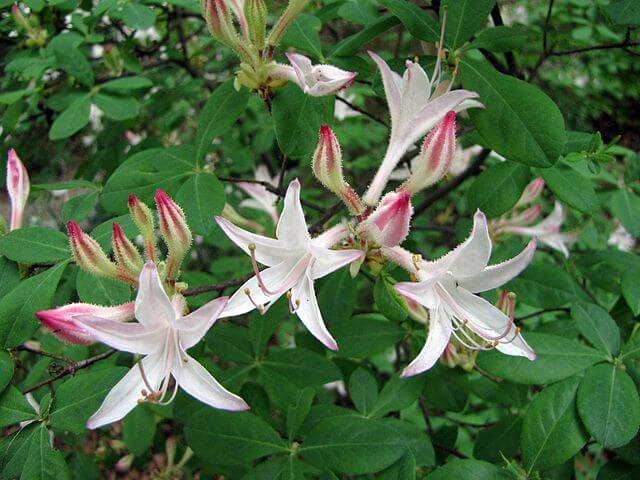

After warming, the bushes are carefully examined and remove frost-damaged, old and diseased branches... Also, when pruning, shoots are removed that are directed inside the bush and thicken the crown.
With the help of timely and competent pruning, you can form an azalea in any geometric shape.
↑ Up,
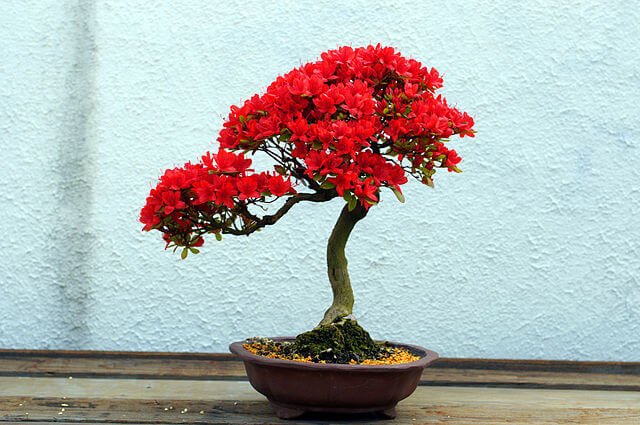

Soil acidification
The acidic components are gradually washed out of the soil, so periodically it must be additionally acidified. Squeeze some juice out of the lemon (literally a few drops) and add it to your water bottle for watering. This should be done about once every one to two weeks, then the soil of the azalea will regularly gradually acidify, which will have the best effect on the condition of the plant.
It is not recommended to use vinegar for acidification, as it kills beneficial soil bacteria and ultimately inhibits and poisons the roots of the plant.
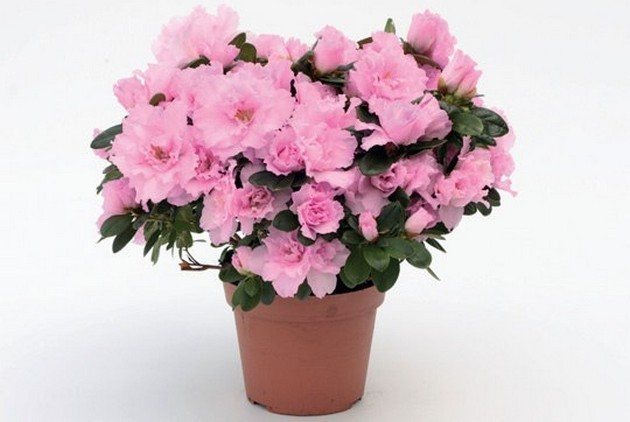

3. Reproduction of azaleas
Possibly vegetative breeding of azaleas stem cuttings, but grafting rarely guarantees a positive result and rooting takes place for a long time. It is especially difficult for deciduous rhododendrons to reproduce in this way.
- Half-matured cuttings 5-10 cm long. with 2 - 3 internodes, they are soaked for several hours in a solution of growth hormones.
- Previously, the upper layer of bark is removed from the lower end of the cutting to a height of about 2 cm.
- When rooting from cuttings remove buds and lower leavesso that the plant does not lose moisture abundantly.
- Cuttings are planted in a nutritious acidic substrate - for example, in peat mixed with sand to a depth of about 1.5 - 3 cm.
- The soil around the planted cuttings is carefully compacted.
- Top cuttings covered with a transparent plastic bag, glass or plastic cover to maintain uniform humidity
- Plants periodically ventilategradually increasing the time. The shelter is removed only after 3 - 4 months, when there is confidence in successful rooting.
- In the room where rooting takes place, the air temperature should be 24 - 26 ° C., it is advisable to use bottom heating.
- Small bushes should not be exposed to direct sunlight.
- First cut carried out when young plants reach a height of 10 - 12 cm.
Not worth using for grafting too old shoots - they will not take root.
↑ Up,
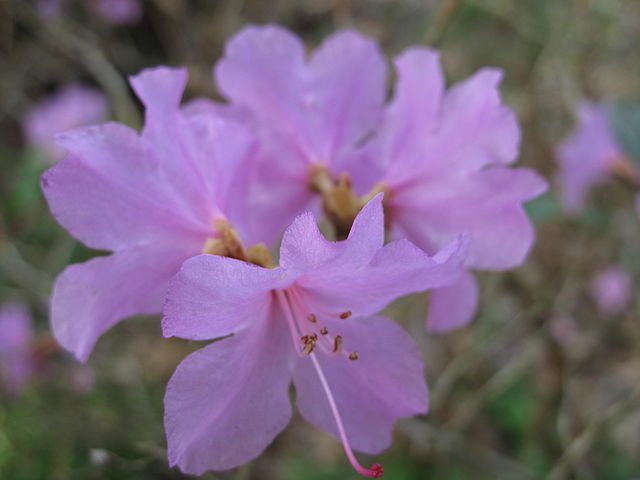

Rhododendrons also breed air layering - for this, long branches located close to the ground are bent, pinned and lightly covered with soil.
After a while, roots appear in the leaf node of such layers.
The successful completion of the rooting process will be indicated by the one that appeared during 2 - 3 months new growth.
↑ Up,
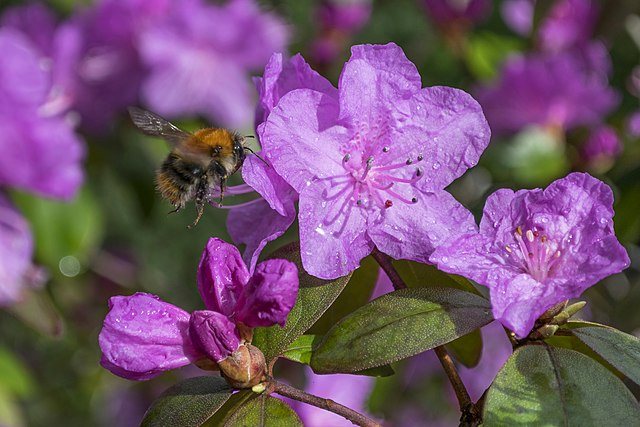

The most rarely used breeding method is growing azaleas from seeds... The fact is that plants obtained in this way may not inherit all the varietal attractiveness of their parents, but first bloom will only come at the age of 3 - 4 years.
Highest percentage germination observed in fresh seeds.
- Sowing spend in the spring into a light, well-hydrated and nutritious substrate.
- Above the seeds are only lightly pressed into the groundwithout covering the top with a layer of soil.
- Instead of watering, use spray humidificationsoftened with water at room temperature.
- Saplings cover up from above transparent plastic cap or glass to maintain an evenly high level of humidity and placed in a well-lit place without exposure to direct sunlight, at a temperature about 20 ° C.
- The first sprouts can be seen within 3-4 weeks.
- With the appearance of the first sprouts, seedlings ventilategradually increasing the time from a few minutes a day.
- Watering spend lower - into the drainage holes of the container.
- Young plants will need a long day of light, so it is advisable to arrange them artificial lighting.
- The sprouts dive into separate cups with the appearance of the first true leaves.
One of the positive aspects of this method of reproduction is the receipt of flowers, initially adapted to room conditions.
If the seedlings are grown for open ground, then the young bushes are taken out into the street for the first time at the age of 3-4 years, gradually hardening and accustoming them to new conditions of detention.
↑ Up,
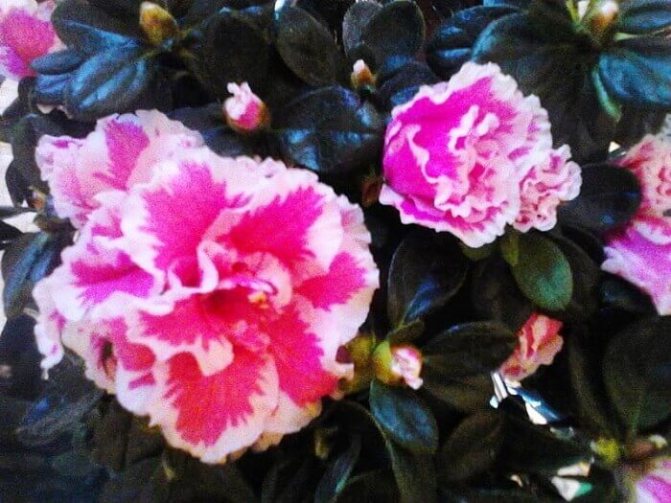

Brief botanical reference
Azalea belongs to the genus Rodendron of the Heather family. The homeland is considered to be China, India and Japan. In the cool mountain forests of China, the plant forms large thickets. In India, they grow as a small tree, and in Japan, the plant has gained popularity as a bonsai and is considered a symbol of joy and peace.


Azalea translated from Greek - "rosewood"
4. Azalea - home care
4.1 How to transplant an azalea
How to transplant an azalea? When is the best time to plant an indoor flower in fresh soil?
The best time to board or transfer is early spring, before or immediately after flowering.
Transplant adult plants only if necessary, every 3 years, in a pot that is larger than the previous one by a couple - three centimeters in diameter.
Never disturb a flowering plant. You should not transplant just purchased plants right away.
Gentle plant handling is the preferred method.
When transplanting, the roots of indoor plants are cut around the entire perimeter of the pot by 3 - 5 cm, and in the rest of the root system, 4 cuts are made about 1 cm deep each.
Since the root system of the flower is located superficially, it is worth picking up for planting shallow and wide pot with large drainage holes.
↑ Up,
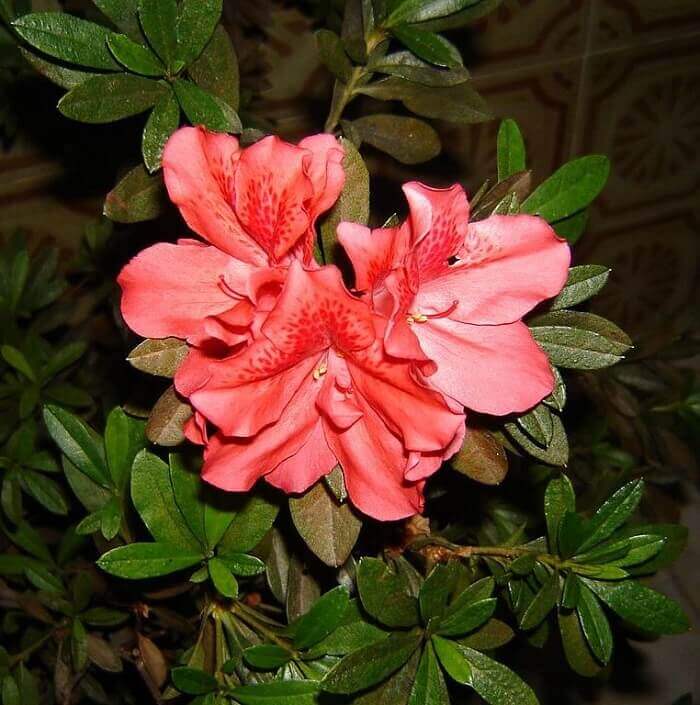

Plant treated in this way planted in fresh soilIt is advisable to use a specially designed for azaleas.
Substrate around the plant after planting tamp with your fingertips to remove air pockets.
It is advisable to shed transplanted bushes epin.
Very important observe planting depth - place the plants at the same depth as in the previous pot. Buried bushes bloom late and their flowering is not so abundant, the plants can rot.
↑ Up,
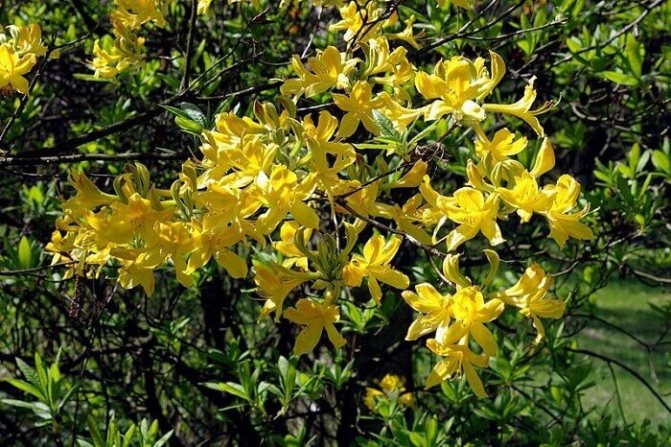

4.2 Primer for azalea
A substrate based on pine bark, high peat, loose leafy soil and coarse-grained river sand, gas and permeable, is well suited for azaleas, good drainage is necessary.
Pick up the soil with pH not higher than 5... The addition of finely chopped pine needles to the soil will acidify the soil.
↑ Up,
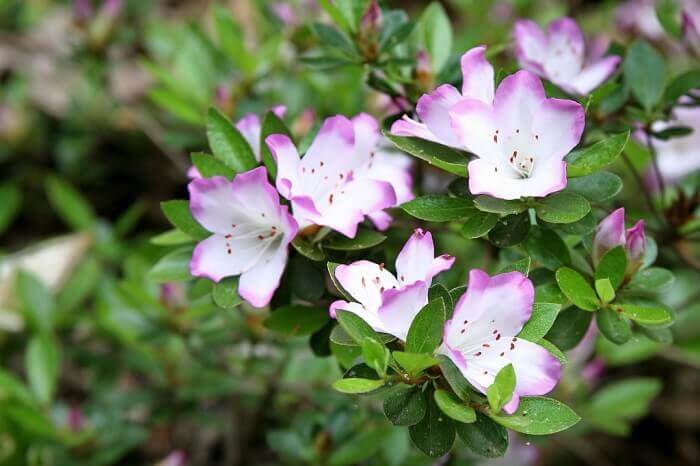

4.3 Flowering
When does azalea bloom? Blooms usually in February - March but the exact time will depend on the variety, with the flowers so numerous that they cover the entire plant.
With sufficient lighting and the necessary cool rest period, the rhododendron will bloom within 3 - 4 weeks, it is quite difficult to achieve repeated flowering.
Blooming azaleas are truly adorable. Shrubs with early flowering may have more buds before the formation of leaves.
↑ Up,
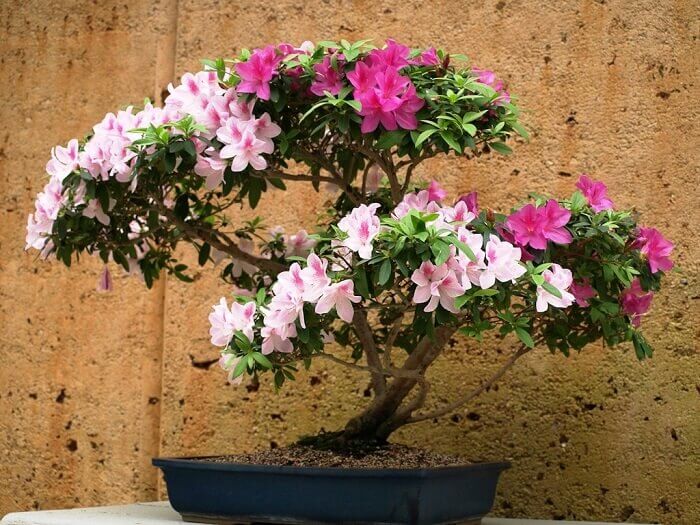

4.4 Growing azaleas - watering
Indoor azaleas need plenty of water - water them regularly.
When the soil dries up, the leaves dry out, the flowers wither.
This plant should not be watered with hard water - use only softened rain or thawed water, you can also sprinkle with bottled water.
You can periodically add to the water for irrigation some lemon juice or ascorbic acid for acidification.
Watering is desirable lower - by immersing the pot in a large container of water. Excess moisture from the pallet should be drained immediately after watering.
↑ Up,
You may also be interested in:
- Begonia - photo, home care, planting, growing in the open field and in a pot, plant flowering, reproduction, soil
- Hydrangea - photo, planting and care, growing in the open field, description, varieties, soil composition for keeping home hydrangea in a pot
- Cyclamen - home care, photos, maintenance after purchase, reproduction - growing from seeds, flowering, transplanting, soil for growing in a pot
- Carnation - photo of a perennial plant, planting and care in the garden, reproduction - growing from seeds, useful properties, soil, watering, fertilization
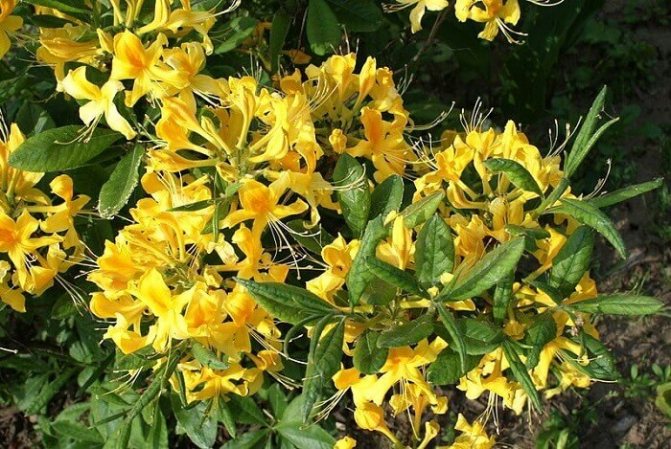

4.5 Air humidity
Air humidity must be high - place the pot of azalea on pallet with wet rubble.
When spraying a fungus may appear on the plant - try to carry out this procedure in the morning. When spraying, droplets of moisture should not fall on buds and flowers.
The plant needs frequent spraying and moderate watering, the soil should never dry out. Do not spray during the flowering period - the water will leave ugly dark spots on the buds and flowers.
Can also be placed next to the plant to increase air humidity room humidifier or use a drip tray with damp pebbles or sphagnum mossthat will naturally humidify the air for a long time.
Potted azaleas can't stand cold drafts.
↑ Up,
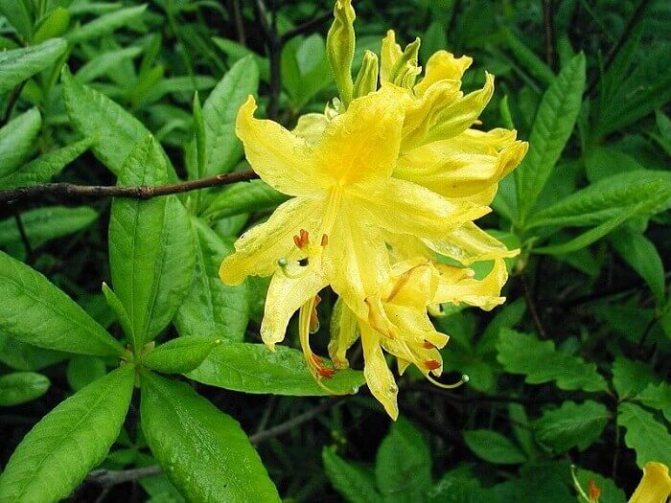

4.6 Care for azaleas after purchase, pruning shrubs
Growing rhododendron is pretty troublesome - only every tenth purchased plant is successfully acclimatized to new conditions of existence.It is worth remembering that only competent care will provide you with long and lush flowering. Consider how to care for an azalea.
It is worth buying flowers in the middle of springwhen active growth begins - in this case it is easier to accustom them to the new atmosphere.
Choosing bushes in a flower shop densely covered with a lot of buds... Naturally, there should be no signs of disease or insect pests on the plant.
A young flower should be purchased in stores - with age, azaleas are more and more difficult to adapt to changing their place of detention. After buying a flower, give it about 2 weeks acclimatization to new conditions and only then transplant.
Pruning rhododendrons after flowering provides abundant branching, which makes them more attractive. Sanitary pruning is the systematic removal of old and diseased shoots. Annual pruning will promote vigorous new growth and more abundant flowering.
The branches that directed into the bush pruned, thereby cutting through the crown and giving the rest of the shoots access to air and light. All manipulations with plants are carried out only with a sharp sterile instrument.
To form standard tree leave a strong erect shoot at the base of the plant and cut off all lateral branches from the trunk. The trunk is wrapped with a dark non-woven material that will allow air to pass to the plant.
Regularly rotate potted plants a few degrees around their own axis - so it will not roll towards the light source.
If possible, take plants to fresh air in the warm season, taking care of shelter from wind, rain and direct sunlight. Cool nights in September with temperatures around 6 - 8 ° C will promote the formation of many buds, so do not rush to bring the plant indoors.
↑ Up,
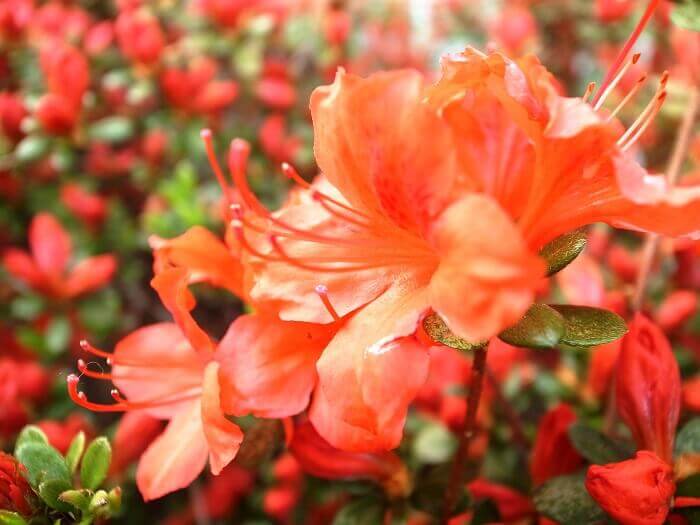

Young shoots stand regularly pinch for better branching.
Do not place azalea pots near heat sources.
If additional shoots appear at the base of the buds of rhododendrons during their formation, they should be removed immediately, otherwise the plant will drop the buds.
Faded buds necessarily pinch to maintain an attractive appearance.
Deciduous rhododendrons, which lose their leaves after flowering, are placed in a cool and dark room for a dormant period.
↑ Up,
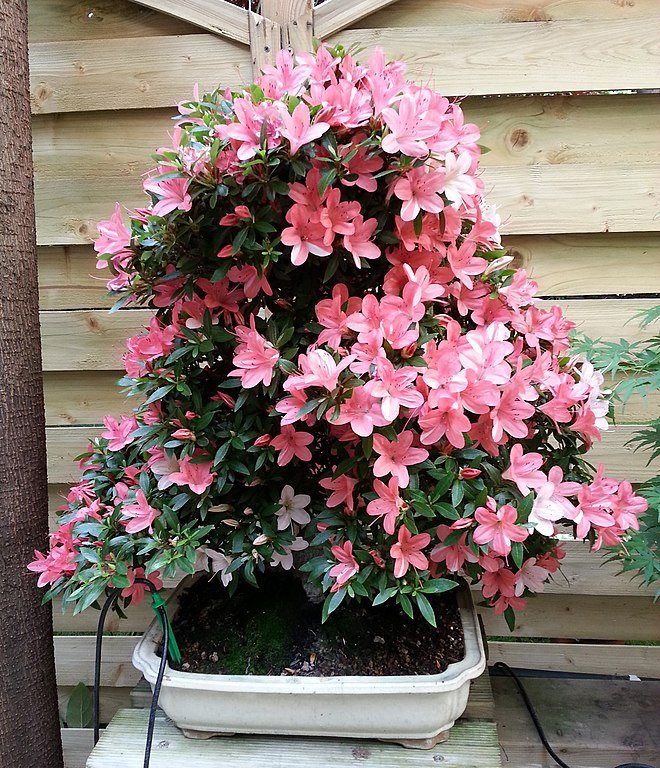

↑ Up,
4.7 Fertilizer
Indoor azalea, when grown in a pot, needs periodic feeding during active growth every 2 weeks.
The flower responds well to both mineraland on organic top dressing.
Nowadays, you can find fertilizers specially made for azaleas and rhododendrons in flower shops.
When a yellowish tint appears on the leaves of the plant, it costs feed with iron chelate every 2 weeks.
Fertilizers for plants must not contain chlorine - it can kill plants.
During the dormant period, which occurs after flowering, the plants are not fed until the first signs of new growth appear.
↑ Up,
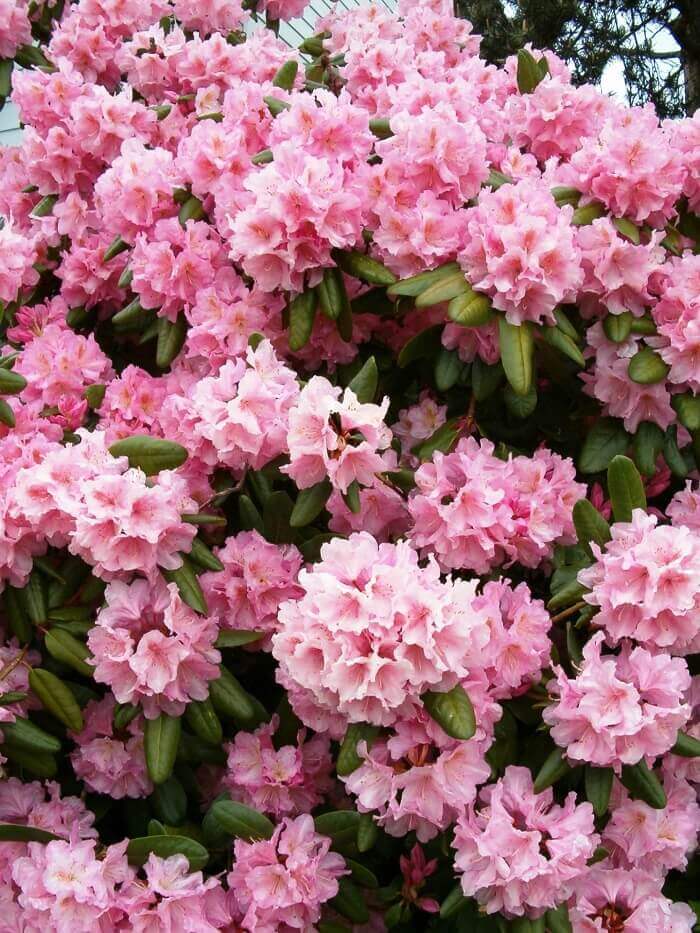

4.8 Temperature
Azalea loves cool - 16 - 21 ° C. Strong heat is very harmful to plants - flowering is significantly reduced, the plant may even die. In summer, you can place the bushes under a plastic dome and cover with ice cubes.
In winter, the bush needs a dormant period of about 2 months. Wintering should take place in a room with a temperature of about 4 - 13 ° C, does not tolerate frost. Winter content temperature should not exceed + 10 ° С at almost 100% humidity.
↑ Up,
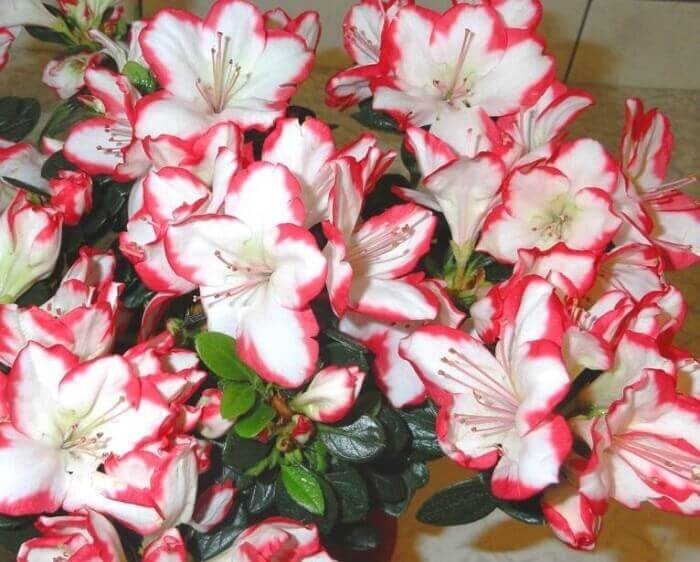

4.9 Lighting
Very bright, direct sunlight can hit the plants in the morning and evening hours... It is better to shade the bushes in the spring and summer daytime hours.
When grown in partial shade, the flowering at the bush will not be plentiful or not at all.Direct sunlight on leaves in the daytime provokes sunburn.
↑ Upward,
You may also be interested in:
- Anemone - flower photo, planting and care in the open field, soil composition for growing in a pot, description, flowering, varieties and types, reproduction
- Adenium - photo, home care, reproduction - growing from seeds, pruning and transplanting a plant, grafting and flowering
- Agatea - home care, planting in open ground, photo, reproduction - growing from seeds, flowering, transplanting, soil for growing in a pot
- Alyssum - photo of a flower, planting and care in the open field, growing from seeds, keeping a plant in a pots - soil, fertilizer, lighting


Fertilizer
The plant consumes nutrients from the soil, the supply of which must be periodically replenished. Once every 2-3 months, apply a special complex fertilizer for azaleas and rhododendrons, which is diluted strictly according to the instructions on the package. It contains all the necessary nutrients, as well as components to increase the acidity of the soil. If it is not possible to get a special fertilizer for azaleas, you can fertilize the plant with any complex mineral fertilizer that does not contain calcium and chlorine.
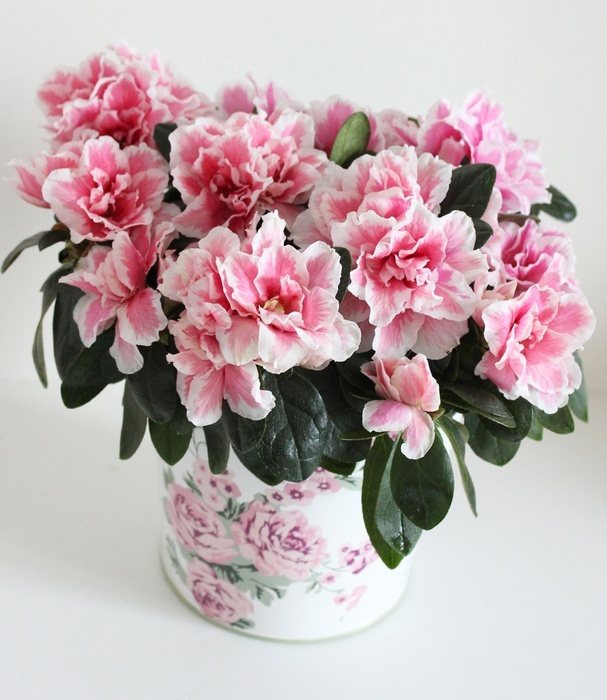

6.Appointment
It is a valuable ornamental plant with a long flowering period... A lively bouquet that, under proper conditions, will thrive for many years.
Azaleas are often used to create blooming bonsai.
Azalea can be shaped as attractive standard tree.
↑ Upward,


Lighting
This plant loves sunlight. A contraindication for her is being in direct sunlight. Soft light or partial shade, if desired, is created on any windowsill, but it is better to settle the azalea on a window that faces west or east.
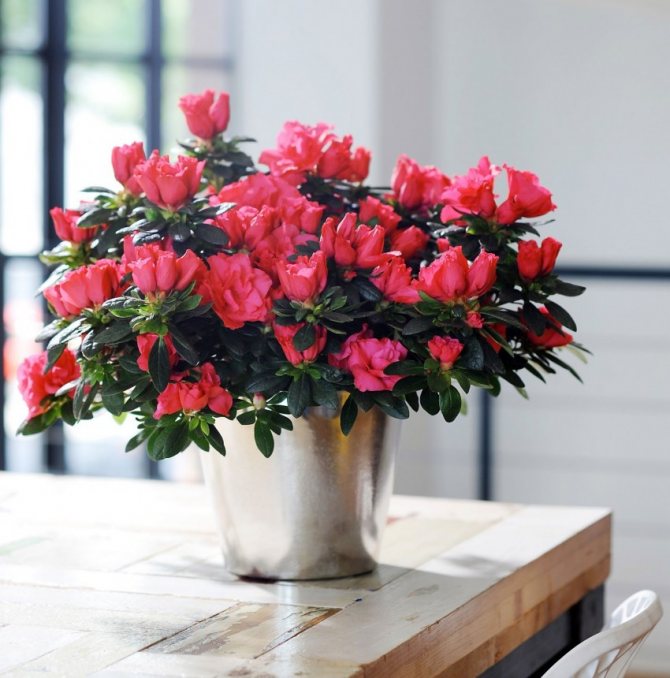

On the north window, the flower may not have enough light, which will cause the foliage to fall off. The problem is solved by lighting the flower with phytolamps. Also, additional light for azaleas is useful during the budding period (October-November).
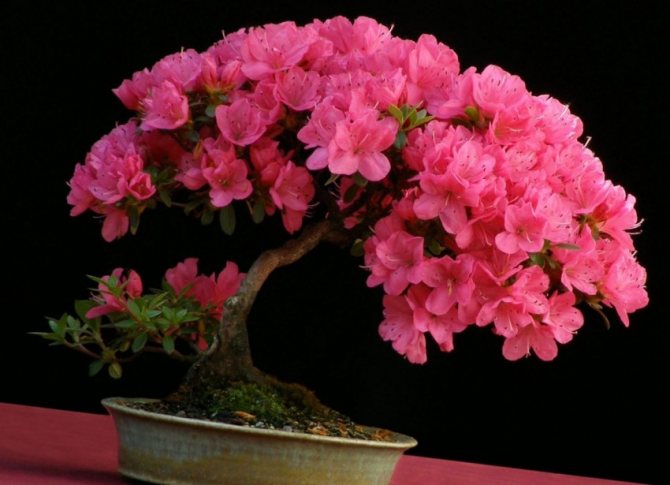

The south side represents the opposite case, where the plant runs the risk of getting too much light and drying out. Then create a shadow with a piece of paper or move the flower away from the window.
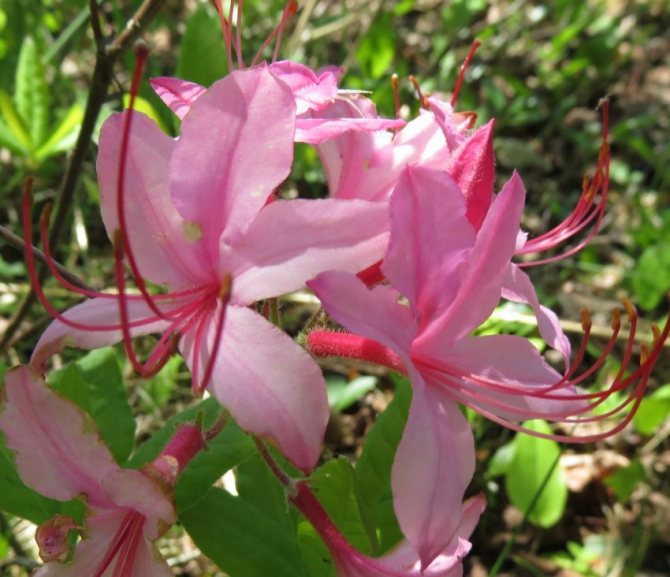

7.Note
Although growing an azalea at home is not easy at all, the plant is very popular among flower growers.
Azaleas pretty demanding on conditions of detention and can die very quickly - the cultivation of such plants requires special knowledge and conditions of detention.
It is believed that the petals of the plant are capable of curing barley in the eye. In Japan, azalea symbolizes feminine attractiveness, it is believed that keeping the plant at home helps to strengthen the family hearth. After working with the plant, be sure to wash your hands - the juice azaleas poisonous - its contact with mucous membranes causes a burning sensation.
↑ Upward,
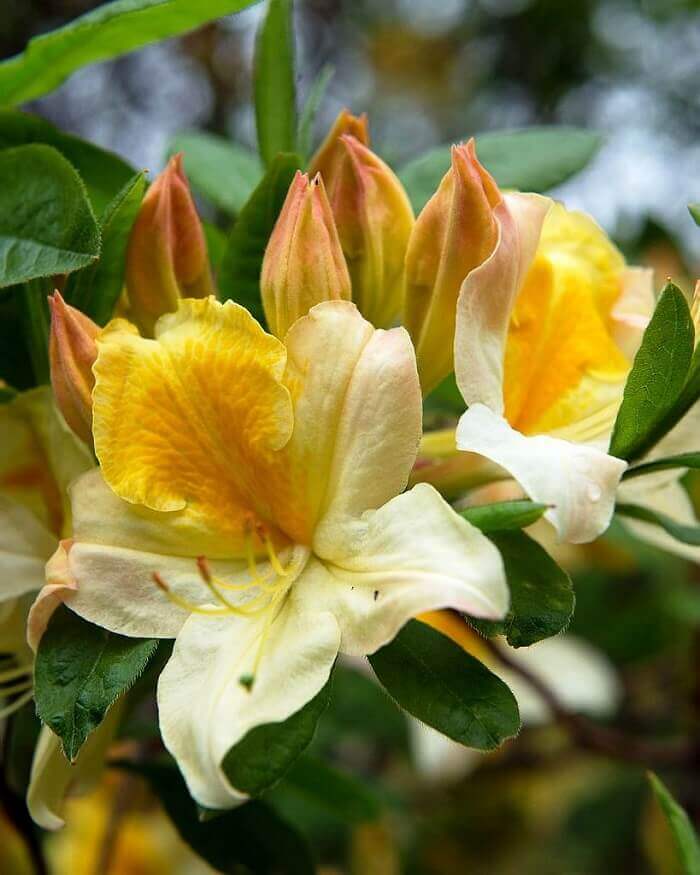

Photo
See more photos of homemade azalea:
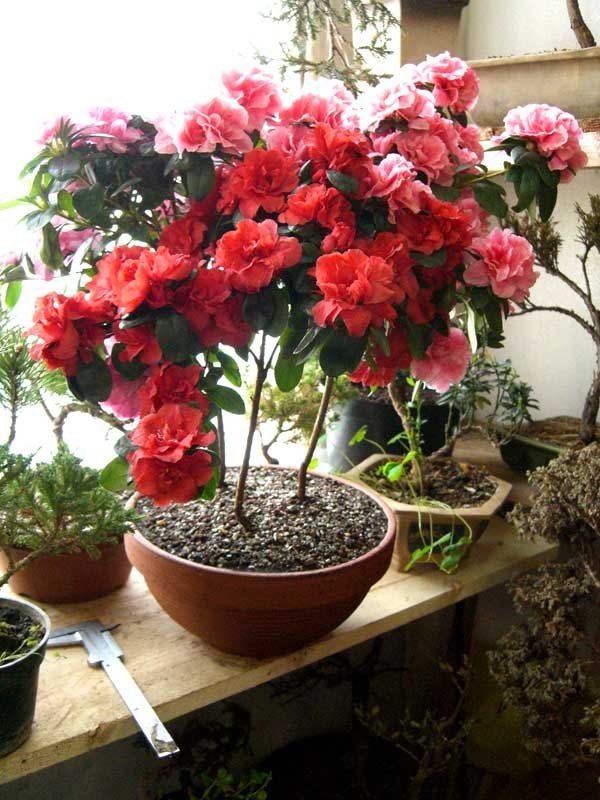

9.Species of azaleas:
9.1. Japanese azalea - Azalea japonica
One of the evergreen subspecies of the plant, shrubs reach a height of 2 m and bloom in spring. The leaves are oblong - oval, light green, slightly bent along the central vein, the leaf blades are glossy. The flowers are funnel-shaped, with slightly corrugated petals in all shades of pink, lilac, salmon, white or red.
↑ Upward,
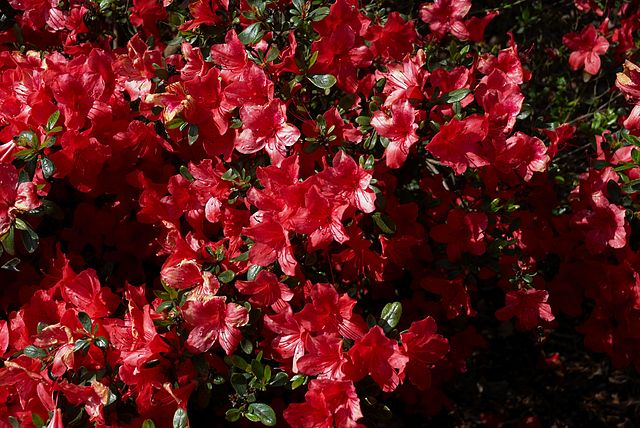

Japanese azalea "Geisha" - Azalea "Geisha" - relatively low plants within 40 - 60 cm. Leaves are glossy, drop-shaped or oblong-oval, young leaves are painted in a lighter shade. The flowers are white, pink, purple, orange, funnel-shaped. There are two-color types.
↑ Upward,


Japanese azalea "Maruschka" - Azalea japonica "Maruschka" - a small evergreen shrub with dark, burgundy oval leaves, reaching a height of 30 - 60 cm.The flowers are large, pinkish - salmon, bloom in May.
↑ Up,
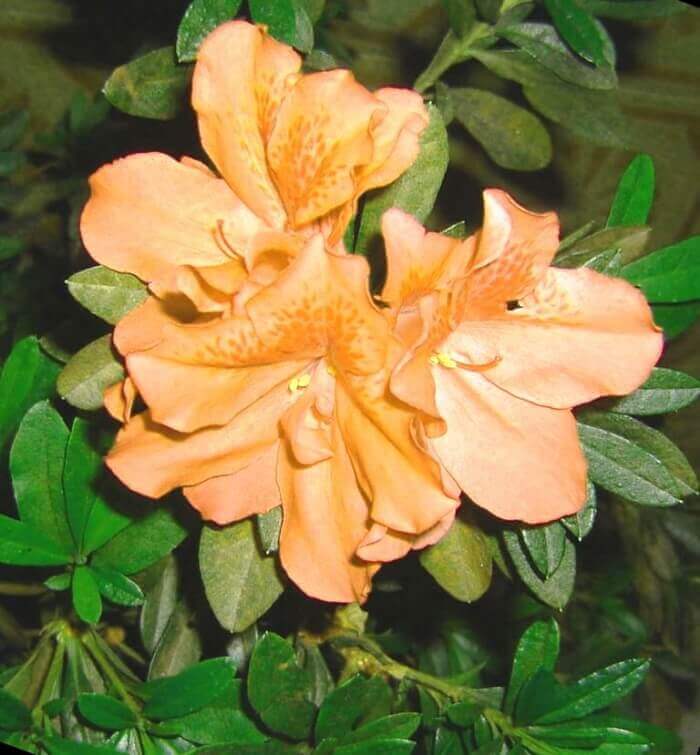

Japanese azalea "Mayshnii" - a compact, profusely branched shrub with thin branches. The leaves are small, oval, green, glossy. The flowers are large, white, pink, lilac, the flowering is so abundant that the plant is completely buried in the buds.
↑ Up,
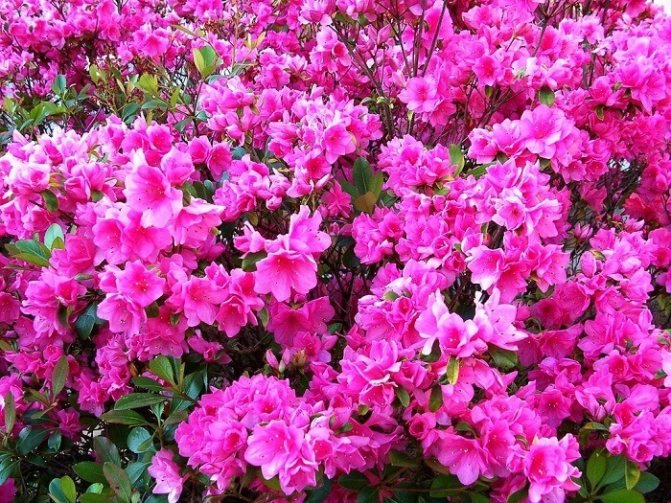

Japanese azalea "Arabesk" - Azalea japonica "Arabesk" - a small evergreen shrub, in height often does not exceed 45 cm. The flowers are very large - up to 5 cm in diameter, funnel-shaped, pink. The leaves are small, dark green, glossy, often turn claret in the winter months.
↑ Up,
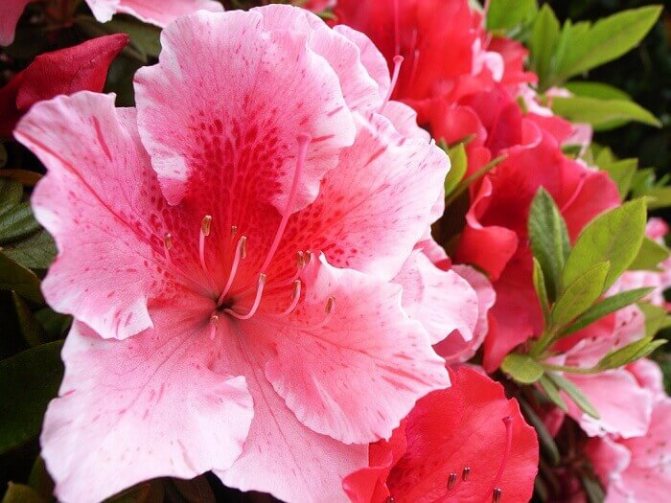

9.2 Deciduous Azaleas or Rhododendrons - Rhododendron
Due to their frost resistance, these plants are often grown on the streets and in gardens. They bloom in late spring to early summer; Blossom flowers include pink, red, purple, yellow and white, depending on the species and variety.
↑ Up,
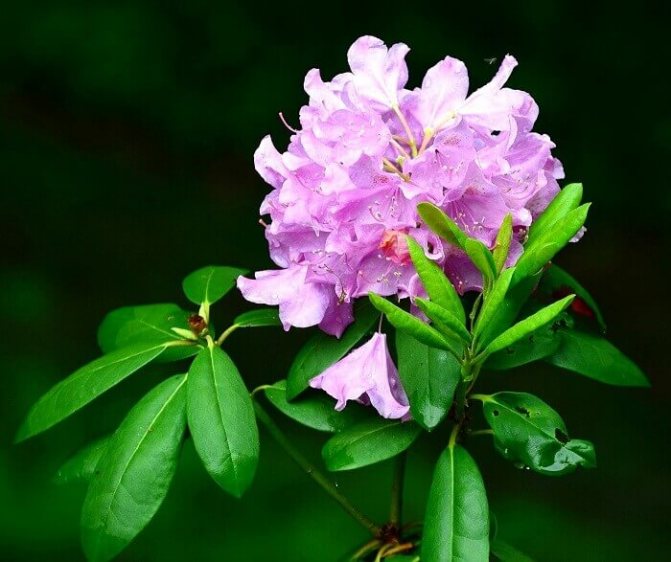

Rhododendron yellow or Azalea Pontic - Rhododendron luteum - among this variety, both deciduous and evergreen plants are found. The leaves are simple, green, often with a short but dense pubescence on the underside of the leaf blade. Flowers are yellow, funnel-shaped, can be located both singly and in small inflorescences at the tops of the shoots. During flowering, these azaleas emit a pleasant fruity scent with sweet notes.
↑ Up,
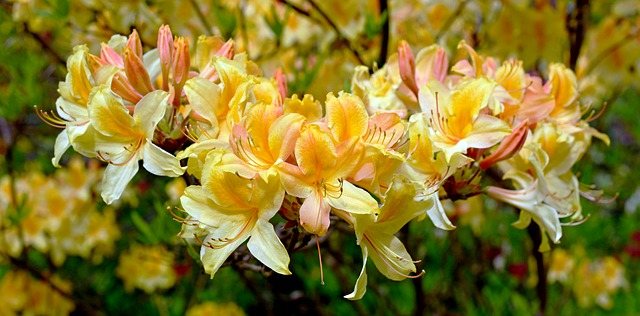

Azalea Golden Lights - Rhododendron "Golden Lights" - a compact, deciduous species, a distinctive feature of which is extremely high frost resistance - plants tolerate frosts down to -30 ° C. Flowering is very abundant, occurs in late spring or early summer, often even before the leaves appear. The flowers are funnel-shaped, salmon or orange-yellow, large. Leaves are simple, green, leaf blades are glossy.
↑ Up,
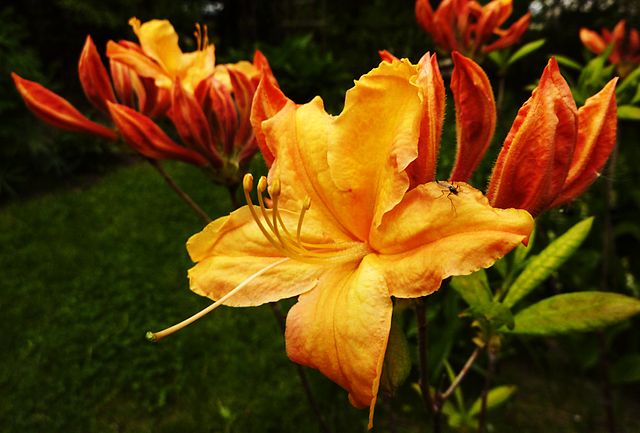

Azalea "Oxydol" - Rhododendron "Oxydol" - deciduous plants with oblong - lanceolate green leaves and large white flowers with an orange or yellow center. The flowers are fragrant, arranged singly or collected in small-flowered inflorescences, open around May. With the onset of autumn, the leaves acquire a bronze tint and crumble.
↑ Up,
Flowering and bush formation
Soon after flowering, the azalea begins its growth period. At this time, new bright green shoots with young tender leaves appear at the ends of the branches. Since indoor azaleas are quite compact plants, young shoots grow very small, only 3-6 cm. At the end of each new shoot, buds are laid for the next flowering.
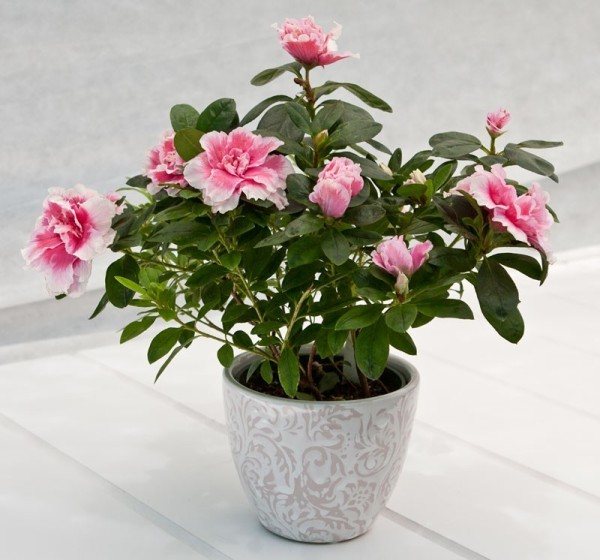

Over time, in the process of growth, the azalea bush loses its beautiful round shape, and there is a desire to slightly align its crown. But there is one trick here: since flower buds are laid at the tips of all new branches, by pruning, you can significantly reduce the number of flowers during the next flowering. Therefore, it makes sense to cut something only in case of emergency: for example, if some branch sticks out very ugly to the side and spoils the whole look of the plant. After pruning, it will not bloom, but the whole bush will look prettier.
Rejuvenation
The first rejuvenation of the plant can be carried out after 3-4 years of cultivation, when the peak of flowering at the bush passes.
In no case should you start the process before and during flowering, otherwise you can ruin the whole bush this way. And since flowering normally continues until the end of spring, the Azalea should be rejuvenated at the beginning of summer.
The main condition is to remove the longest or thickest shoots. Of course, weak, dry, wilting stems are also cut off.
Also, during transplantation, a similar procedure should be carried out with weak roots. With this action, it will turn out to make the bush especially fragrant and renewed.
How to choose the right plant?
The tips for choosing an Azalea are about the same as for buying most houseplants:
- It is much preferable to choose a flower on which the first buds have just been outlined. It is worth adhering to this rule in the first place, since the plant in any case experiences stress when moving from its usual environment. But it was noticed that not in a blooming state, Azalea quickly adapt to new conditions.
- It is recommended to assess the external condition of the bush. To do this, it should be carefully tilted. If the base has withering or even dry leaves, then it is obvious that such an Azalea grew in an uncomfortable place for itself. There is a risk that it will not survive the move and will quickly wither away.
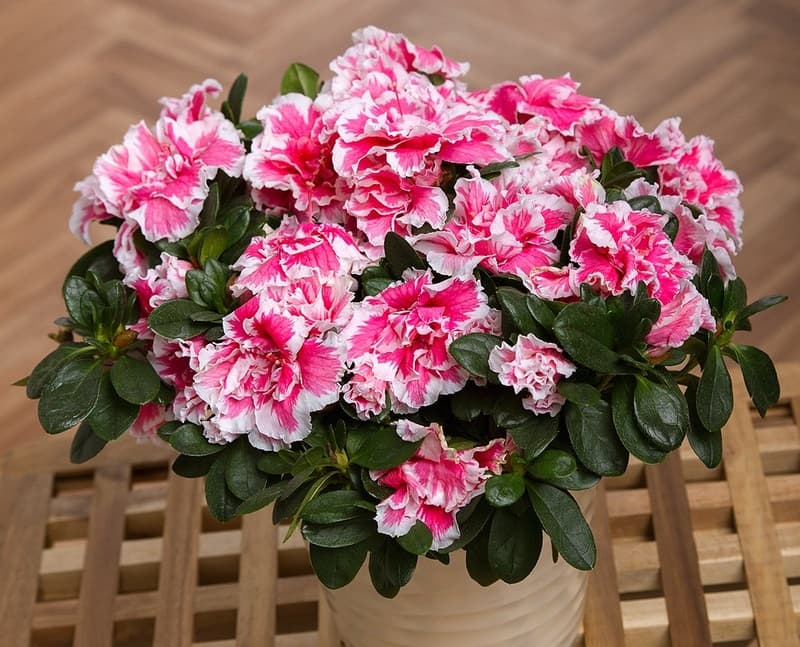

Potted azalea
If an already flowering plant is purchased, then the only recommendation is not to try to transplant it immediately into a new pot. It is better to wait until the flowering ends, or at least reaches its peak. Otherwise, there will be very little chance of successful survival of such a magnificent flower.
Varieties
All varieties of azaleas come from two main types:
- Indian azalea (rhododendron) - Sims azalea;
- Japanese azalea.
Japanese azalea
It is a very compact and low shrub, growing only up to 60 cm in height.
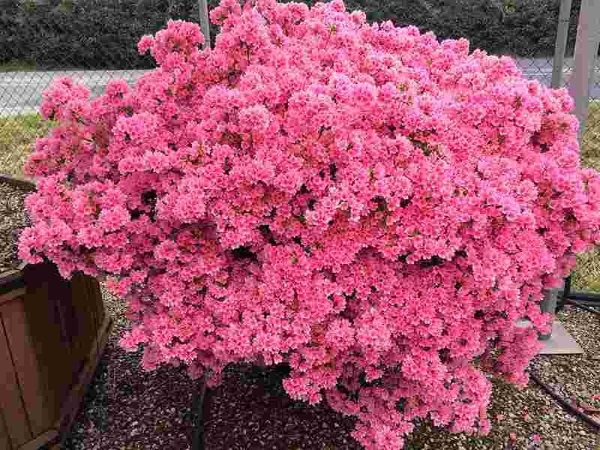

Creates a dense cap of flowers, can grow easily with temperature fluctuations.
- Melina is a perennial plant with carmine flowers, rather large, up to 5 cm.
- Kermesina Alba is a bush completely covered with white flowers, spectacular and very delicate.
Humidity level
This is one of the most important factors. Dry air can simply kill a flower.
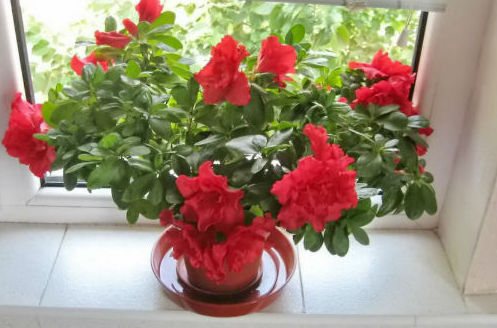

Azalea flower in a deep pan
Here's what you can do to keep the humidity at the proper level:
- Choose a deep tray for the pot;
- Cover the pallet with pebbles and moss;
- Observe that there is moisture in the pan;
- Spray the leaves during flowering; When spraying with a spray bottle, try to keep the droplets small.
Watering
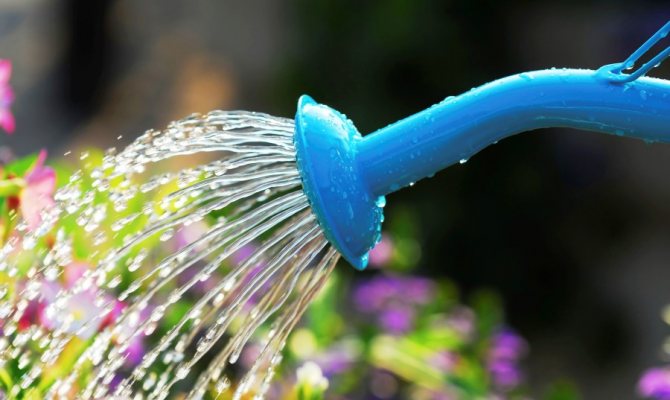

At the same time, indoor rhododendron does not tolerate stagnant moisture. It is enough to pour the soil a couple of times to provoke the development of fungal diseases of the root system.
If you have to be absent for several days and there is no one to entrust such a delicate task, you should take care of the plant in advance. For this it is enough:
- add a handful of vermiculite or perlite;
- mulch the soil with pine bark;
- place near containers with water to increase humidity;
Pruning
To get a branchy lush bush and many flowers, it is necessary to engage in the formation of the azalea crown annually. This is done by pinching the elongated shoots. Some of them do not grow to the desired length, they are left and pinched for the next year.
Pruning encourages the azalea to plant more buds. The beginning of May is the standard time when all new shoots are cut to form inflorescences there. After flowering, all dry parts are also removed so as not to take away nutrients from the buds and shoots.
Florist reviews
The most important rule that I have determined for myself is watering only in the pallet, and abundantly, especially in summer. Now, in preparation for flowering, he drinks water from the sump in front of our eyes in a matter of minutes. And the second is the obligatory removal of dry twigs, yellowed leaves, faded and unblown buds after flowering, and pinching the upper branches so that the plant will again delight you with its flowering. Otherwise, caring for her is not particularly difficult, the main thing is to choose the right place, she does not like dry air, does not like direct sunlight.
mona
Many friends tell me that the azalea does not take root in them, the leaves turn yellow and fall off, they cannot wait for the beginning of flowering. I usually have a pot with this flower in the kitchen, on the windowsill, under which the battery does not pass, and even then in winter we often have the battery disconnected in the kitchen. Therefore, the flower is comfortable, not hot or cold.And from May to October, the azalea stands on the loggia, as it does not tolerate the heat well, and at night it is cooler there. Azalea requires regular watering, the soil should be moist all the time. Sometimes I put the pot in the bathroom and water from the shower with fine nozzles. When the plant gets too hot, I take ice from the fridge and cover the pot.
Topolina
Azalea is a very whimsical flower. It definitely doesn't suit me, I have a huge number of plants, but I don't want an azalea. She needs constant, daily care. As a rule, we are all in a hurry and sometimes there is simply no time to take care of. And so the flower is insanely beautiful, there are so many varieties of it, they are all beautiful! My friend has azalea, but she is very meticulous and pedantic in character, she constantly fertilizes and sprays her. And that, in gratitude to her, blooms twice a year with a beautiful big hat. She never waters the azalea, she always pours water into the sump. She also does not recommend turning the plant, in general it is better not to move or rearrange. Azalea is very susceptible to various diseases.
elenaav
Adapting to a new room
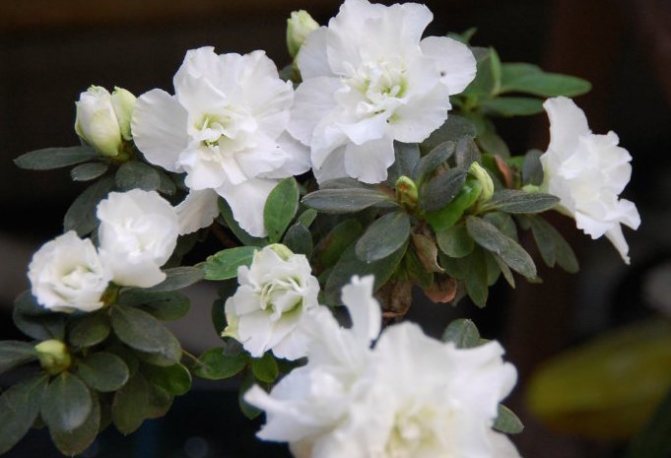

You can be sure that the azalea has fully adapted only when, after moving from the flower shop to the home windowsill, the plant will bloom and sprout further. In such a rather exciting period, you should take care of the flower with the utmost care. And carefully observe how he behaves.
Azalea does not like heat very much, therefore it is better to remove the pot away from heating systems. In addition, they are very badly affected by low humidity levels. The more coolness he gets during habituation, the more chances that the flower will remain alive.
You shouldn't rush with fertilizers either. During their stay in the nursery, the azalea is arranged in already overfed soil, so that the flower can live peacefully until it hits the store counter.
If you follow all these rules, you just have to wait.
A special spraying called "Epin" can help in getting used to. This substance is a special biostimulant for indoor plants.
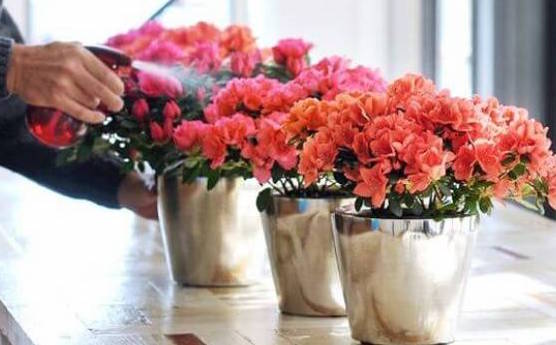

Spraying azaleas
Its action helps the plant to reveal its own protective functions, raises the level of immunity and resistance to stress. The instructions for use can be read on the packaging, and spray about once every ten days.
Top dressing
For decorative, profusely flowering crops, the most necessary are potash-phosphorus fertilizers. You can use ready-made mixtures for indoor azaleas - the plant absorbs them well.
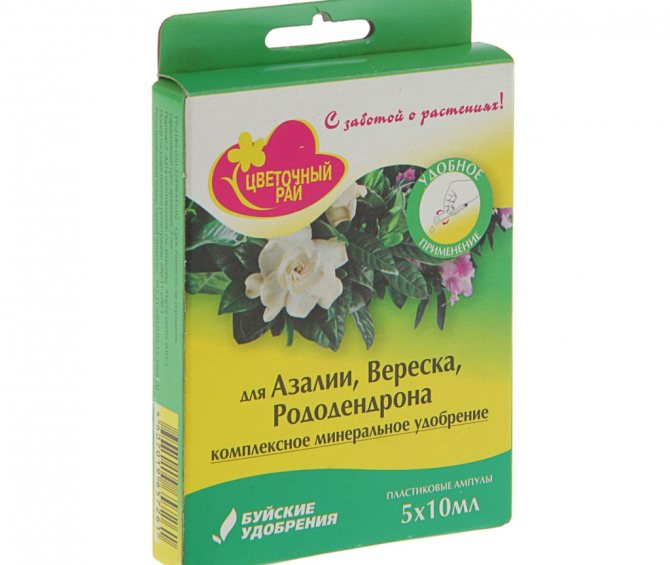

Most of the potassium and phosphorus is applied before and during flowering. Further, the frequency of feeding is reduced. During the resting period, the azalea does not feed, so higher doses of fertilizers can cause root problems.
Common mistakes when caring for flowers
They are always associated with impaired care:
- The buds and leaves are shriveled. The room is very hot, there is not enough fresh air, little moisture.
- Leaves turn yellow, fall off without identifying parasites. Poorly selected soil.
- No flowers or sparse peduncles. Low acidity of the soil.
- Flowers with a dull shade, few rosettes, they are small. Lack of light.
- The plant goes only to the leaf part, there are no flowers, the plate of sheets is of a dull shade. Little heat. Flowers need warmth and light rays, but without excess.
- Forgot about the pruning and did it at the wrong time. This is the biggest mistake. Pruning is done not during flowering, but after it. If the beginner missed the period, the bush is left so until next year.
- Frequent transplant. The plant will not give flowers, will go to the leaf and root parts.
Do not forget that the azalea is turned from time to time, and with an excess of heat, the pot is transferred to the shade.
The main diseases and pests, how to deal with them
Rhododendrons, if not properly cared for, can be attacked by pests and suffer from various diseases.The most dangerous are the following.
Spider mite. It appears on the underside of the leaf and gradually envelops the entire plant in a thin web. The tick feeds on the sap of the plant. Treatment: spraying with Agravertine solution.
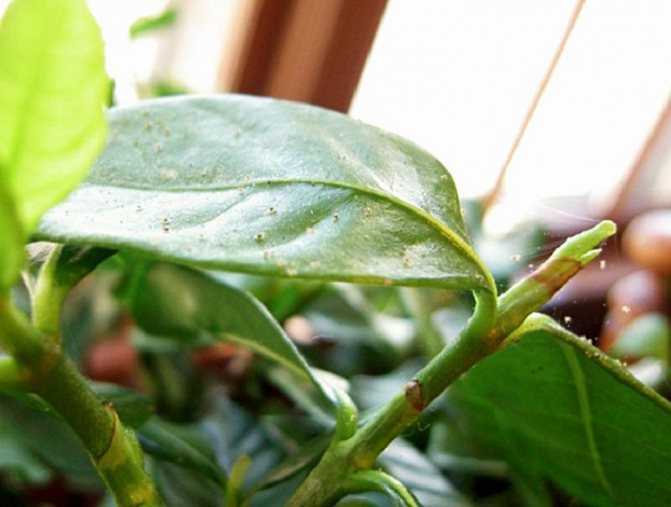

The terrible enemy of the azalea
Rhododendron bug... The most common pest that lays eggs in foliage tissues. Young insects appear in summer. To get rid of the bug, you need to spray the plant with Diazinin.
Plowed slug... They live only on young garden plants. Without treatment, the pest destroys the young plant completely. Control measures: foliage treatment with 0.8% TMTD solution.
Asian garden beetle... A very dangerous insect. It destroys leaves, damages the root system and the stem of the plant. With untimely assistance, it leads to the death of the plant.
Bean aphid... It feeds on plant sap, which often leads to its death. Treatment consists in treating the bush with a solution of Karbofos.
Late blight. The disease appears at high temperature and humidity, primarily affecting fragile roots. Control measures: treatment with Bordeaux liquid.
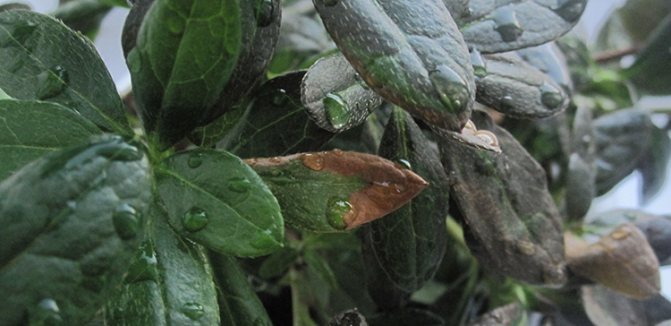

Fungal disease leading to the death of the flower
Septoria. The fungus can settle on a plant with insufficient lighting, high humidity, waterlogged soil and untimely pruning. Treatment: treatment with fungicides.
How to get rid of midges in indoor flowers using simple methods. In a special publication of our portal, we will tell you in detail how to get rid of pests in indoor flowers. You will learn the reasons for their appearance, the types of midges and their signs and measures to prevent the appearance of midges.
Azalea pests (video):

